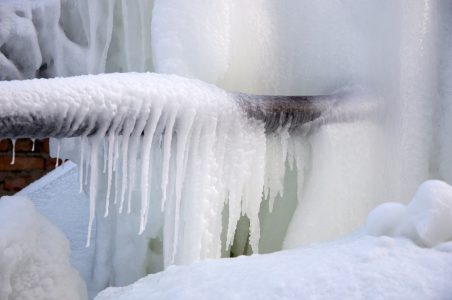Tips to Defend Plumbing System from Freezing: Key Advice
Tips to Defend Plumbing System from Freezing: Key Advice
Blog Article
The author is making a number of great observations on Helpful Tips to Prevent Frozen Pipes this Winter in general in this content down the page.

Cold weather can ruin your pipes, particularly by freezing pipes. Here's how to avoid it from happening and what to do if it does.
Introduction
As temperatures decline, the risk of icy pipelines rises, potentially bring about costly repairs and water damage. Comprehending how to stop icy pipes is crucial for homeowners in cold climates.
Recognizing Frozen Pipes
What causes pipes to ice up?
Pipelines ice up when subjected to temperatures listed below 32 ° F (0 ° C) for prolonged durations. As water inside the pipes ices up, it increases, taxing the pipeline walls and possibly creating them to burst.
Threats and damages
Icy pipes can cause water disturbances, residential property damages, and costly repair work. Burst pipes can flooding homes and cause extensive architectural damages.
Indicators of Frozen Water Lines
Recognizing frozen pipes early can stop them from bursting.
How to determine icy pipes
Search for lowered water flow from taps, unusual odors or sounds from pipelines, and visible frost on revealed pipelines.
Prevention Tips
Protecting vulnerable pipes
Cover pipes in insulation sleeves or make use of warm tape to safeguard them from freezing temperature levels. Focus on pipelines in unheated or external locations of the home.
Heating strategies
Keep interior spaces adequately warmed, specifically areas with plumbing. Open cupboard doors to permit warm air to circulate around pipelines under sinks.
Shielding Outdoor Plumbing
Yard hoses and outside taps
Separate and drain pipes yard hose pipes before winter. Set up frost-proof spigots or cover outside taps with shielded caps.
What to Do If Your Pipelines Freeze
Immediate activities to take
If you presume icy pipes, maintain faucets open up to relieve pressure as the ice thaws. Use a hairdryer or towels soaked in warm water to thaw pipelines gradually.
Long-Term Solutions
Architectural changes
Take into consideration rerouting pipes away from outside walls or unheated areas. Include added insulation to attic rooms, cellars, and crawl spaces.
Upgrading insulation
Purchase high-grade insulation for pipes, attic rooms, and wall surfaces. Correct insulation assists keep constant temperature levels and reduces the threat of frozen pipes.
Final thought
Avoiding frozen pipelines calls for aggressive steps and fast feedbacks. By understanding the reasons, indicators, and safety nets, home owners can secure their plumbing during winter.
6 Proven Ways to Prevent Frozen Pipes and Protect Your Home
Disconnect and Drain Garden Hoses
Before winter arrives, start by disconnecting your garden hoses and draining any remaining water. Close the shut-off valves that supply outdoor hose bibs and leave the outdoor faucet open to allow any residual water to drain. For extra protection, consider using faucet covers throughout the colder months. It’s also important to drain water from any sprinkler supply lines following the manufacturer’s directions.
Insulate Exposed Pipes
Insulating your pipes is an effective way to prevent freezing. Pipe insulation is readily available at home improvement stores and is relatively inexpensive. Pay close attention to pipes in unheated areas such as the attic, basement, crawl spaces, or garage. Apply foam insulation generously to create a buffer against the cold. You can also wrap your pipes in heat tape or thermostat-controlled heat cables for added warmth.
Seal Air Leaks
Inspect your home for any cracks or openings that could let in cold air. Seal any holes around the piping in interior or exterior walls, as well as the sill plates where your home rests on its foundation. Additionally, make sure to keep your garage door closed unless you’re entering or exiting. Leaving it open creates a significant air leak that can lead to frozen pipes.
Allow Warm Air Circulation
During cold snaps, it’s essential to allow warm air to circulate evenly throughout your home. Leave interior doors ajar to promote better airflow. Open kitchen and bathroom cabinets to help distribute heat consistently around the rooms. If you have small children or pets, be sure to remove any household chemicals or potentially harmful cleaners from open cabinets for safety.
Let Faucets Drip
A small trickle of water can make a big difference in preventing ice formation inside your pipes. When temperatures drop significantly, start a drip of water from all faucets served by exposed pipes. This continuous flow helps prevent the water from freezing. Additionally, running a few faucets slightly can relieve pressure inside the pipes, reducing the chances of a rupture if the water inside does freeze.
https://choateshvac.com/6-proven-ways-to-prevent-frozen-pipes-and-protect-your-home/

Do you like more info about How to Prevent Your Pipes From Freezing? Give a remark down the page. We will be happy to find out your feelings about this blog posting. We hope that you visit us again in the future. Are you aware of anybody else who is in to the topic? Please feel free to share it. We truly appreciate your readership.
This Website Report this page